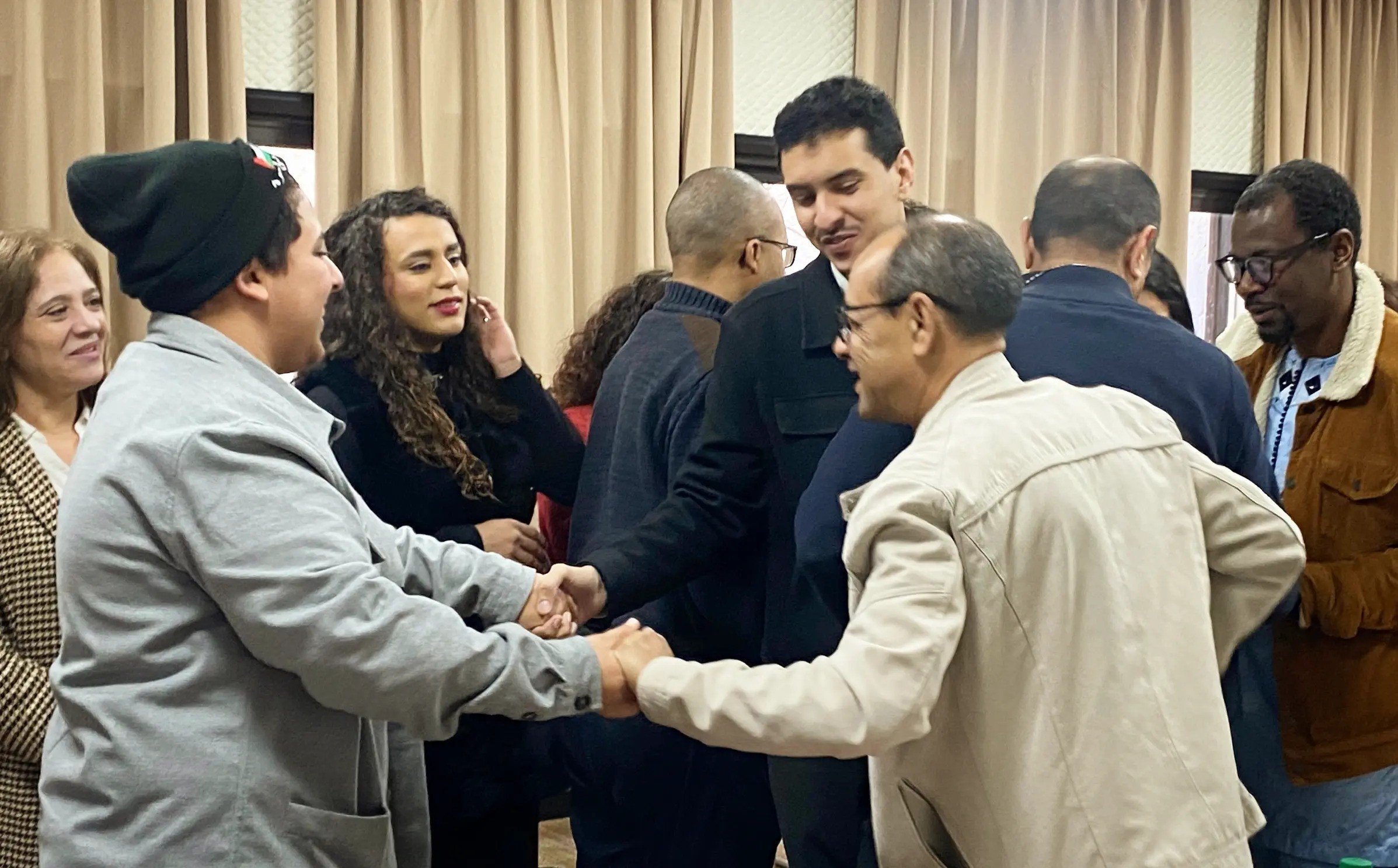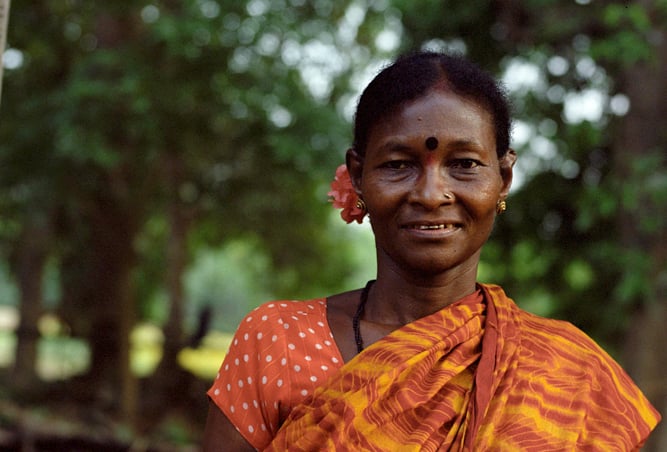Saharawis in Morocco
-
Profile
During 1975–91, Saharawis fought a bitter war against occupying Moroccan, and until 1978, Mauritanian forces. Saharawis are of mixed Berber, Arab and black African descent. They inhabit the harsh desert region stretching from southern Morocco to the valleys of the Niger and Senegal and traditionally lived a nomadic life as traders. The assembly (djemaa) established its own body of law, the A’arf, to complement the basic Islamic judicial code, sharia. Under harsh conditions and dispersal no single group has been able to draw on sufficient power or resources to establish even a semblance of supra-tribal government.
Estimated population: 90,000 (various sources)
Historical context
As nomads, Saharawis were distinct from Berber Tuareg nomads to their east, as well as from black African farmers to the south, and semi-nomadic or sedentary Berbers to their immediate north. Saharawi society is highly stratified along tribal, caste and gender lines. Politically each tribe and faction regulated its affairs through djemaa of the heads of its most distinguished families, men who enjoyed the greatest respect. The first European contact with Western Sahara was made by Portuguese traders in the fifteenth century and a lucrative trade in slaves and gold started. In the late nineteenth century Spain laid claim to the territories. In 1934 the French succeeded in gaining the border regions of north-western Sahara while the Spanish continued to govern the Spanish Sahara as an appendage of the protectorate in northern Morocco.
Until the late 1950s most Saharawis were still nomadic. Their lives began to change rapidly when the territory’s rich mineral resources became known to the West. The Western Sahara has rich iron ore and phosphate deposits onshore, and suspected oil reserves offshore. It is also one of the best fishing zones in the world, unexploited by the Saharawis. The economic changes of the 1960s and early 1970s brought about the rapid modernization of Saharawi society; a majority of the population became sedentary, while the urban population trebled in seven years. Inspired by Moroccan radicals who had brought about Moroccan independence in 1956, Saharawis rebelled against the French and Spanish in the region, but it was not until 1971–2 that the anti-colonial movement was effectively organized, largely by Saharawi living in Morocco and Mauritania. On 10 May 1973 the Polisario Front was formed, growing rapidly into a mass movement. In 1975 thousands of pro-Polisario demonstrators took to the streets to greet a UN mission of inquiry which found there to be an ‘overwhelming consensus among (West) Saharans … in favour of independence’.
Since 1956 Morocco has laid claim to a vast portion of the Algerian Sahara, the whole of the Western Sahara and Mauritania and the northwest tip of Mali. The Mauritanian government however viewed any loss of Western Saharan territory as a grave security threat in view of the 1,570 kilometre border between the two countries. Almost half of this border is within 50 kilometres of the strategic iron ore railway upon which Mauritania depends for 85 per cent of its export earnings. In response to the series of UN resolutions on the holding of a referendum on the self-determination of Western Sahara, King Hassan II of Morocco was determined to thwart what was clearly a prelude to independence. Hoping to force Spain to cede the territory to Morocco, he launched a patriotic crusade to recover the ‘Moroccan Sahara’ and aroused enormous enthusiasm among Moroccans. He massed 20,000 troops near the Western Saharan border and forced a postponement of the referendum pending a decision on the dispute at the International Court of Justice (ICJ) in The Hague. The referendum was never held and in 1975 the ICJ found that neither Mauritania nor Morocco had ties of sovereignty with Western Sahara. Precluding the judgement, Morocco and Mauritania had reached agreement with Spain according to which Spain would cede the Western Sahara to both countries in return for fishing and other interests. On 14 April 1976 Western Sahara was formally partitioned with two-thirds of the territory going to Morocco. This division of Western Sahara was carried out without consideration of Saharawi determination to resist annexation. Polisario had consistently rejected any settlement which did not grant the territory full independence within its pre-1975 borders. Refugees began to leave the disputed area and within six months 50,000 people were living in camps on Algerian territory. These camps were soon populated almost entirely by women and children as men left to join Polisario’s Saharawi Peoples Liberation Army (SPLA). An independent Western Saharan state, the Saharan Arab Democratic Republic (RASD) was proclaimed by Polisario on 27 February 1976.
The war was unpopular with most Mauritanians. Many were Moors, thus related to the Saharawis, while others, black Africans, saw it as an inter-Arab affair. In July 1978, following a military coup in Mauritania, a peace agreement was signed according to which Mauritania abandoned all claims to Western Saharan territory. Morocco, on the other hand, intensified the fighting, seizing Dahkla and naming Tiris el Gharbia a Moroccan province. In March 1980, Hassan began building a Great Wall of the Sahara from the Algerian border in the north-east to the Atlantic Coast. By 1988 the wall was 1,600 kilometres long and covered almost two-thirds of the territory. Morocco maintained 100,000–200,000 troops there and received military backing from France and the USA. The wall was highly fortified, constructed of sand banks, minefields and barbed wire with intermittent artillery placements and observation posts. It effectively pushed the guerrillas further into the desert. By the end of the 1980s Morocco was in undisputed control of 80 per cent of Western Sahara, but 140,000 troops were needed to maintain this elaborate system. Hopes for a peaceful, just settlement rose when former UN Secretary General Perez de Cuellar launched a peace plan in August 1988. In September 1991 the UN began developing a multinational force to supervise a ceasefire and organized a referendum.
King Hassan continued to regard Moroccan withdrawal as unthinkable. It would have offended nationalist sentiments shared by most major political parties and army officers, and risked his political survival. The UN meanwhile was unwilling to risk destabilizing Morocco given the escalation of civil war in Algeria during the 1990s. Internationally, the Polisario Front’s Saharan Arab Democratic Republic won diplomatic recognition from 72 states whereas Hassan failed to secure recognition of Morocco’s claim. While the UN committed itself to sending military police and civilian units as part of the UN Mission for a Referendum in Western Sahara (MINURSO) to oversee the partial withdrawal of the Moroccan forces, it did not pressure Rabat to carry out the referendum. There was some concern about whether a free and fair referendum could take place. Voter registration plans were complicated by the fact that Saharawis are traditionally nomadic, in addition to refugee and migrant flows resulting in the settlement of many people outside the territory’s arbitrary colonial borders. A 1975 Spanish census counted only those physically within the border of Spanish Sahara, recording 73,497 people. In July 1991 the Moroccan government presented the UN with lists of 120,000 Moroccans who had settled there since 1975, threatening to swamp the core list.
Although King Hassan announced an amnesty for all Polisario fighters on 12 June 1991 and subsequently freed about 3,000 civilian Saharawi prisoners, hundreds of ‘disappeared’ Saharawis remained unaccounted for, being either dead or still in secret detention. Morocco was determined to avoid voting in areas beyond its control and the Forces Armées Royales (FAR) staged air strikes in August 1991 beyond the wall, bringing an end to the de facto ceasefire that had prevailed since early 1990. Algeria’s war in the 1990s weakened Polisario’s position there and hampered efforts to improve conditions for the tens of thousands of Saharawi refugees in Algeria.
The standoff continued, and in 1997 former US Secretary of State and UN Special Envoy James Baker began three years of a mediation effort between Morocco and Polisario. Some agreements were reached, including a release of prisoners of war, but the sides failed to agree on voter eligibility for the referendum. A compromise solution he put forward in 2001 that would have granted the Saharawis a referendum on independence four years after a transitional period with broad autonomy but under continued Moroccan rule was rejected by Polisario and its ally, Algeria. The UN put forward a similar proposal in 2003 that met greater acceptance from Polisario but was rejected by Morocco.
Current issues
Morocco has consistently refused to allow a referendum, and in October 2006, the UN Security Council extended the 15-year-old UN peacekeeping mission for a further six months. Following a May 2005 crackdown by Moroccan authorities, a September 2006 UN report leaked to the press raised concerns about Saharawis suffering police brutality, torture, lack of freedom of expression or due process. Nevertheless, Moroccan ally France blocked proposals to include these concerns in the latest UN resolution prolonging the peacekeeping force.
Attempts were made to break the deadlock over Western Sahara in 2007. In June 2007, the two sides – the Moroccan government and the Algerian-based Polisario Front – held talks under the auspices of the UN in New York for the first time in ten years. This followed a United Nations Security Council resolution 1754 in April, which called for the two parties to hold unconditional talks to achieve “a mutually-acceptable political solution providing for the self-determination of the people of Western Sahara”. It remains unclear whether the 2007 contacts have yielded anything positive, although more discussions are scheduled for 2008. However, in December 2007 the Polisario Front held a party conference in Tifariti is located near a so-called “defence wall” erected by Rabat in the 1980s to repel rebel attacks. The Polisario Front regards it a “liberated area.” It is only the second time that the Polisario have held a conference in the buffer zone, and Morocco protested to the UN Secretary-General , that the move was a violation of the 1991 UN-brokered ceasefire. The dispute may yet sour any prospects for forthcoming discussions.
A controversial July 2005 fishing agreement between the EU and Morocco, pending approval by the European Parliament, would allow EU fishing vessels to catch in occupied Western Sahara’s rich coastal waters. Of a Saharawi population of around 250,000, some 160,000 remain displaced in southern Algerian refugee camps.
Related content
Latest
-

15 April 2024
Enhancing grassroots organizational resilience in a shrinking civic space
Grassroots civil society organizations in the MENA region are excluded from high-level policy spaces and lack sufficient skills to…
Minority stories
-

28 October 2015
Afro-Descendants: A Global Picture
Drawing on a range of case studies, this publication seeks to highlight the invisibility and discrimination that persist for people of African descent to this day, as well as celebrate their achievements as activists, artists and citizens.
- Central Africa
- Discrimination
- Minority stories
Reports and briefings
-
1 January 1984
The Sahrawis of Western Sahara
The Sahrawi people is fighting for its survival, working to reverse the illegal sale of its territory, in 1975, by the previous colonial…
-
Our strategy
We work with ethnic, religious and linguistic minorities, and indigenous peoples to secure their rights and promote understanding between communities.
-
-
